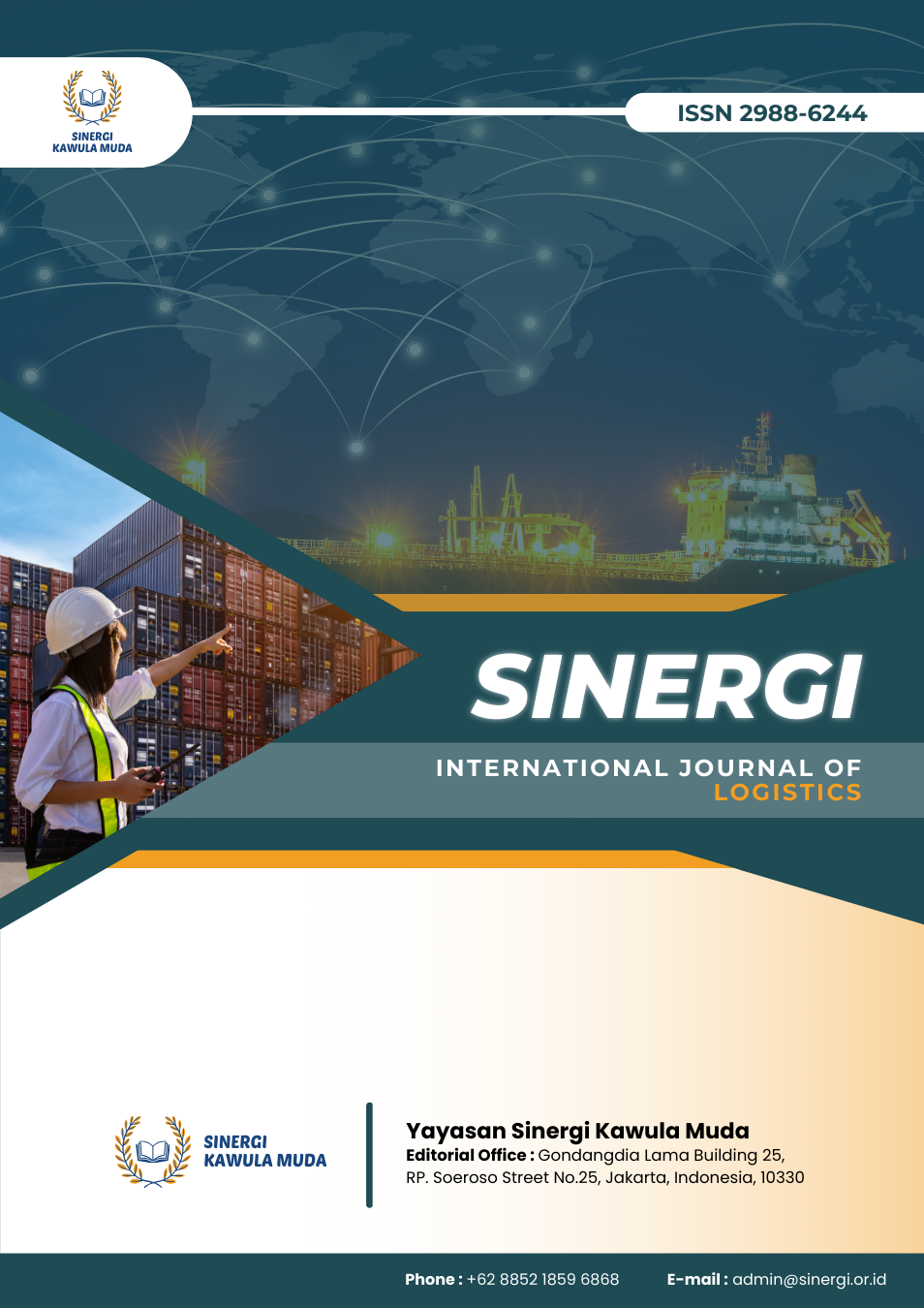Transforming Logistics Education in Higher Institutions: The Role of Digital Technologies in Global Training Contexts
DOI:
https://doi.org/10.61194/sijl.v3i1.737Keywords:
Digital Logistics Education, Virtual Reality in Logistics, Digital Twins, Artificial Intelligence, Education Technology, Logistics Training, Workforce ReadinessAbstract
This paper explores the current state of digital logistics education and training, emphasizing the integration of advanced technologies such as virtual reality, digital twins, and artificial intelligence. The purpose of the study is to examine the impact of these technologies on learning outcomes and to identify the barriers that limit their effectiveness. A comprehensive literature review was conducted using databases such as Scopus and Google Scholar, with a focus on studies related to digital education, logistics, and technological adoption. The findings reveal that technologies such as virtual reality (VR) significantly improve engagement and concept mastery in logistics simulations, while artificial intelligence (AI) enhances personalized learning pathways. However, challenges such as insufficient infrastructure. The review highlights the importance of aligning curricula with industry needs and fostering greater collaboration between academia and industry. Policy recommendations include investing in digital infrastructure, enhancing educator training, and designing inclusive curricula that can accommodate diverse student populations. The study concludes with recommendations for future research to explore the long-term effects of digital training and the development of standardized evaluation methods for emerging educational technologies in logistics.
References
Almenara, J., Guillén‐Gámez, F., Ruiz‐Palmero, J., & Palacios‐Rodríguez, A. (2021). Classification models in the digital competence of higher education teachers based on the digcompedu framework: logistic regression and segment tree., Vol 17 No 1 (2021): Journal of. https://doi.org/10.20368/1971-8829/1135472
Almenara, J., Guillén‐Gámez, F., Ruiz‐Palmero, J., & Palacios‐Rodríguez, A. (2021). Teachers' digital competence to assist students with functional diversity: identification of factors through logistic regression methods. British Journal of Educational Technology, 53(1), 41-57. https://doi.org/10.1111/bjet.13151 DOI: https://doi.org/10.1111/bjet.13151
Amare, E., Zegeye, R., Wondie, S., Tamire, T., & Siyoum, M. (2024). Getting ready for digital shift: the level of acceptance towards educational technology among faculty members in higher education institutions in ethiopia. Discover Education, 3(1). https://doi.org/10.1007/s44217-024-00090-1 DOI: https://doi.org/10.1007/s44217-024-00090-1
Cresci, M., Yarandi, H., & Morrell, R. (2010). The digital divide and urban older adults. Cin Computers Informatics Nursing, 28(2), 88-94. https://doi.org/10.1097/ncn.0b013e3181cd8184 DOI: https://doi.org/10.1097/NCN.0b013e3181cd8184
Drozdova, M. and Fursova, E. (2023). Peculiarity and functionality of the digital educational ecosystem for transport and logistics. E3s Web of Conferences, 383, 03001. https://doi.org/10.1051/e3sconf/202338303001 DOI: https://doi.org/10.1051/e3sconf/202338303001
Emre, A., Somuncu, S., Korkmaz, M., & Demirci, E. (2024). Conceptual awareness levels of digital logistics among turkish university students. Humanities and Social Sciences Communications, 11(1). https://doi.org/10.1057/s41599-024-02907-8 DOI: https://doi.org/10.1057/s41599-024-02907-8
Kondrat’Ev, V., Popov, V., & Kedrova, G. (2022). Industrial policy priorities under industry 4.0. World Economy and International Relations, 66(3), 73-80. https://doi.org/10.20542/0131-2227-2022-66-3-73-80 DOI: https://doi.org/10.20542/0131-2227-2022-66-3-73-80
Korepin, V., Дорожкин, Е., Mikhaylova, A., & Давыдова, Н. (2020). Digital economy and digital logistics as new area of study in higher education. International Journal of Emerging Technologies in Learning (Ijet), 15(13), 137. https://doi.org/10.3991/ijet.v15i13.14885 DOI: https://doi.org/10.3991/ijet.v15i13.14885
Minculete, G. and Olar, P. (2020). Supply chain management, key factor in modern education and training of logistics managers. https://doi.org/10.12753/2066-026x-20-027 DOI: https://doi.org/10.12753/2066-026X-20-027
Ogrizović, D., Hadžić, A., & Jardas, M. (2021). Fully immersive virtual reality in logistics modelling and simulation education. Promet - Traffic&transportation, 33(6), 799-806. https://doi.org/10.7307/ptt.v33i6.3941 DOI: https://doi.org/10.7307/ptt.v33i6.3941
Suntai, Z. and Beltran, S. (2022). The intersectional impact of race/ethnicity and sex on access to technology among older adults. The Gerontologist, 63(7), 1162-1171. https://doi.org/10.1093/geront/gnac178 DOI: https://doi.org/10.1093/geront/gnac178
Yoon, H., Jang, Y., Kim, S., Speasmaker, A., & Nam, I. (2020). Trends in internet use among older adults in the united states, 2011–2016. Journal of Applied Gerontology, 40(5), 466-470. https://doi.org/10.1177/0733464820908427 DOI: https://doi.org/10.1177/0733464820908427
Youssef, A., Dahmani, M., & Ragni, L. (2022). ICT use, digital skills and students’ academic performance: exploring the digital divide. Information, 13(3), 129. https://doi.org/10.3390/info13030129 DOI: https://doi.org/10.3390/info13030129
Marquezan, C., Granville, L. Z., & Almeida, J. M. (2014). Software-defined networks in cloud logistics. Computer Networks, 68, 115–128.
Muñuzuri, J., Cortés, P., Onieva, L., & Guadix, J. (2020). Port logistics digitalization: A challenge for emerging economies. Maritime Policy & Management, 47(5), 563–578.
Nair, R. (2014). Internet infrastructure and logistics innovation in emerging markets. Asian Journal of Infrastructure Development, 8(1), 45–60.
Numair, A., Fatima, S., & Rasheed, R. (2021). Digital skills gap in logistics: An emerging market perspective. Journal of Logistics & Workforce Development, 3(4), 104–122.
Pan, Y., Zhou, H., & Zhang, W. (2023). Predictive analytics in cloud logistics: A performance review. Journal of Digital Supply Chains, 9(1), 25–46.
Samanta, S., Bera, S., & Chakraborty, S. (2021). Organizational adaptation in cloud-based logistics: A theoretical review. Global Journal of Logistics and SCM, 14(2), 98–112.
Sharmila, R., Mathews, A., & Chandra, S. (2024). Bridging policy and practice in cloud logistics. Policy & Technology Journal, 18(1), 11–29.
Sivakumar, G., Rajendran, C., & Choudhary, S. (2020). Legal and regulatory issues in cloud-based logistics. Journal of Business and Law in Technology, 12(3), 212–229.
Toka, O., Fajfar, P., & Novak, R. (2013). Hybrid cloud deployment for logistics management systems. Computing and Informatics, 32(2), 429–451.
Tran, B. X., Le, H. T., & Phan, H. T. (2022). Digital infrastructure and logistics efficiency: Evidence from Southeast Asia. Asian Development Journal, 39(2), 87–109.
Wernimont, A., Hall, P., & Chang, R. (2019). Digital transformation in high-tech logistics sectors. International Journal of Supply Chain Technology, 7(3), 146–165.
Downloads
Published
How to Cite
Issue
Section
License
Copyright (c) 2025 Muhammad Rifqy Naufal Abdillah, Muhammad Wahyuilahi

This work is licensed under a Creative Commons Attribution 4.0 International License.





